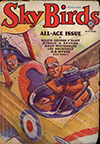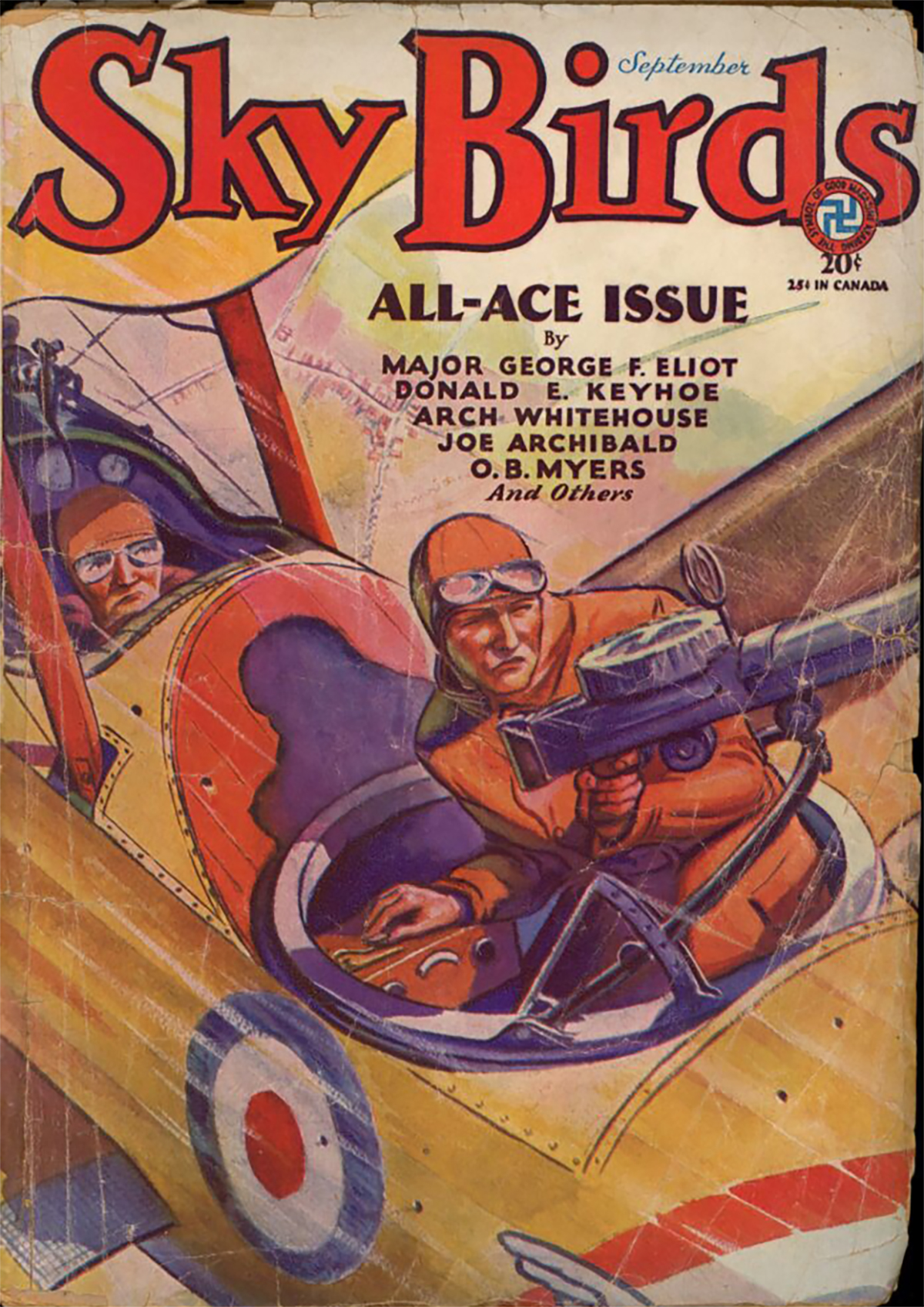“Above the Fog” by Erle Stanley Gardner
THIS week we have 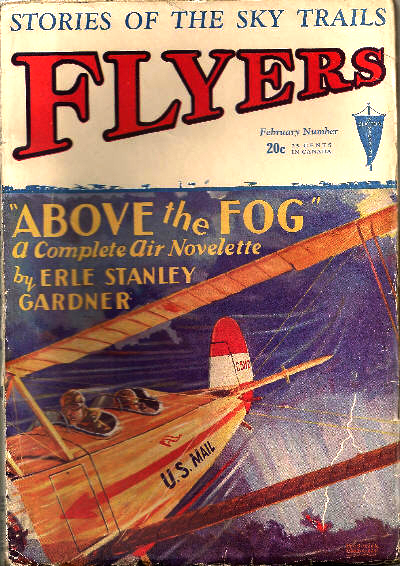 a story by the one and only Erle Stanley Gardner! Yes, the Erle Stanley Gardner. Gardner, of course, best known for his Perry Mason stories, wrote numerous other novels and shorter pieces both under his own name and a slew of pseudonyms for both books and magazines. He was also wrote numerous nonfiction books that were mostly narrations of his travels through Baja California and other regions in Mexico. According to wikipedia, Gardner was “the best-selling American author of the 20th century at the time of his death.”
a story by the one and only Erle Stanley Gardner! Yes, the Erle Stanley Gardner. Gardner, of course, best known for his Perry Mason stories, wrote numerous other novels and shorter pieces both under his own name and a slew of pseudonyms for both books and magazines. He was also wrote numerous nonfiction books that were mostly narrations of his travels through Baja California and other regions in Mexico. According to wikipedia, Gardner was “the best-selling American author of the 20th century at the time of his death.”
When a beautiful woman drops out of the swirling mists of fog looking for directions at the Oakland airport, she accidentally leaves behind a purse whose contents may or may not be linked to at least one murder and who knows what else—and it sends Dave Flint on a mission to find the girl and return the bag—even if it means his life! From the pages of the February 1930 issue of Flyers, it’s Erle Stanley Gardner’s “Above the Fog!”
There may be no adventure left on the ground these days, but above the fog. . . .
- Download “Above the Fog” (February 1930, Flyers)
AS A bonus, here’s a brief article about Erle Stanley Gardner that appeared in the pages of the newspaper magazine This Week, the week prior to the supplement serializing his latest novel Fugitive Gold!
An Adventure Every Day
That’s the life of Erle Stanley Garner, whose new serial,
“Fugitive Gold,” begins next week
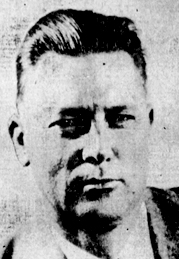 A STRANGE apparition of squat, chain-like things slowly crawls across a cacti-dotted section of our Southwestern desert and finally takes shape—a string of automobiles and trailers.
A STRANGE apparition of squat, chain-like things slowly crawls across a cacti-dotted section of our Southwestern desert and finally takes shape—a string of automobiles and trailers.
A depression riddled clan seeking new life and some small fortune in a change of scene? A new health-movement idea? Or perhaps a gold-seeking expedition hunting a lost mine? No, none of these—though the last is warm. It is merely the home and office of one of America’s most popular authors, whose latest serial, “Fugitive Gold.” begins next week in these pages.
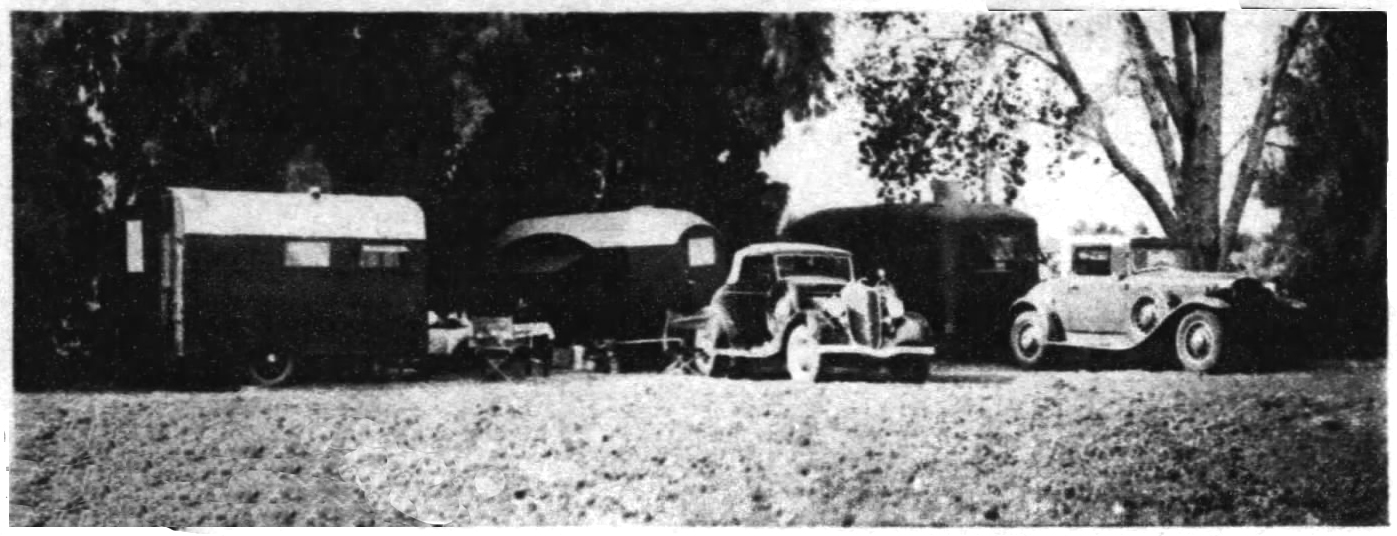
The fiction train on location.
At a glance, it is evident that Erle Stanley Gardner is not the drawing-room, cocktail-drinking type, but a virile, nature-loving man who lives the same sort of vigorous and adventurous life as the heroes of his stories. He is medium height and stocky and wears a wide sombrero and the look of one who has spent much time in the outdoors.
Mr. Gardner’s early life was spent on the Pacific coast. He was admitted to the California Bar when he was twenty-one and found his first clients among those who made their livings from underworld activities. With prohibition, organised crime increased and so did his work and its accompanying dangers.
Once Mr. Gardner, lest he should talk too much, was kidnapped by gangsters and held prisoner in a hideout house, the gangsters expecting a pitched battle with the police. The events of those hours remained indelibly seared upon his memory.
The skill which Mr. Gardner exhibited in the trial of jury cases, however, gradually led to his dropping of criminal cases, and he became widely known as a trial attorney specializing in cases tried before juries. Some ten years ago he wrote his first magazine stories and in 1933 his first book, “The Case of the Velvet Claws.” He has given up the law, of course, and today devotes all his time to writing.
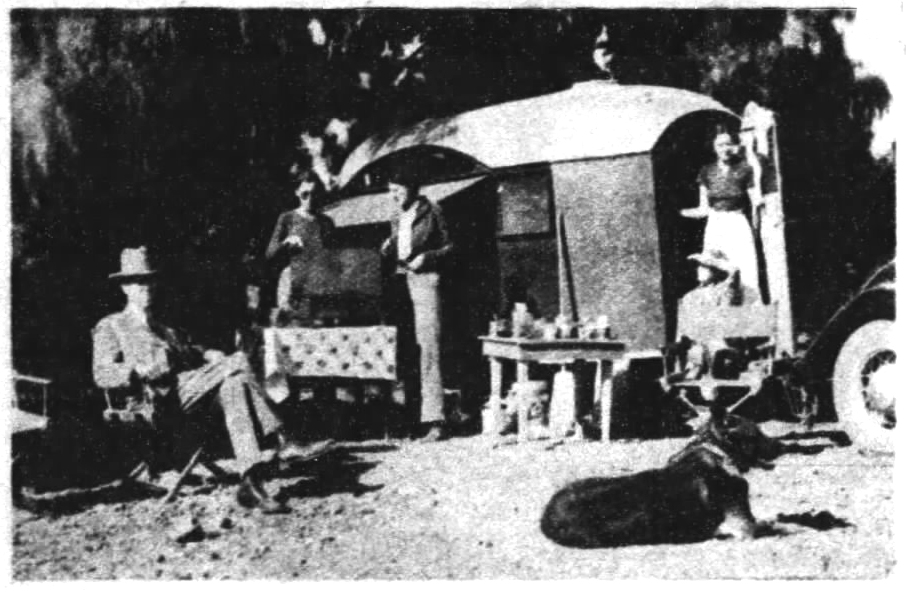
Lunch time on the road.
Erle Gardner has traveled all over the world, but he loves and belongs to the Southwest of which be writes so colorfully and fascinatingly—and so convincingly. Convincingly, because he relies only partly upon imagination for plots, preferring to supplement his stories from first-hand contact. It is not surprising, therefore, that he has found himself in more positions of personal danger than the average man would in two lifetimes.
Upon one occasion, seeking a lost gold mine (much the same as the lost mine that plays so important a part in “Fugitive Gold”) he was challenged by two horsemen, one of whom “cut down” on him with a six-shooter. Gardner finally outdistanced them in his car, felt chagrined when safe, and returned, rifle in hand, “to see what it was all about.” The horsemen stared at him, both fingering their guns; he stared at them. At last a wordless truce was declared and they went their own ways. Such a type of man is Erle Stanley Gardner, the author.
An author? But how does he live in this house on wheels? How does he get any work done? The interviewer stands a little abashed as Mr. Gardner gently explains: “There are three trailers, all self-contained living units. There are double beds; closets; water tanks; stoves; windows; awnings; screens; ice-boxes and radios.
“As to getting work done, I use dictating machines for first drafts of stories and I can dictate fast enough to keep all three of my secretaries busy transcribing. These secretaries, incidentally, have been with me since I began writing eleven years ago and travel everywhere with Mrs. Gardner and me. Two years ago we went to China and left the secretaries behind, but I won’t do that again. There were lots of times I was punching the portable when there were priceless experiences to be had.”
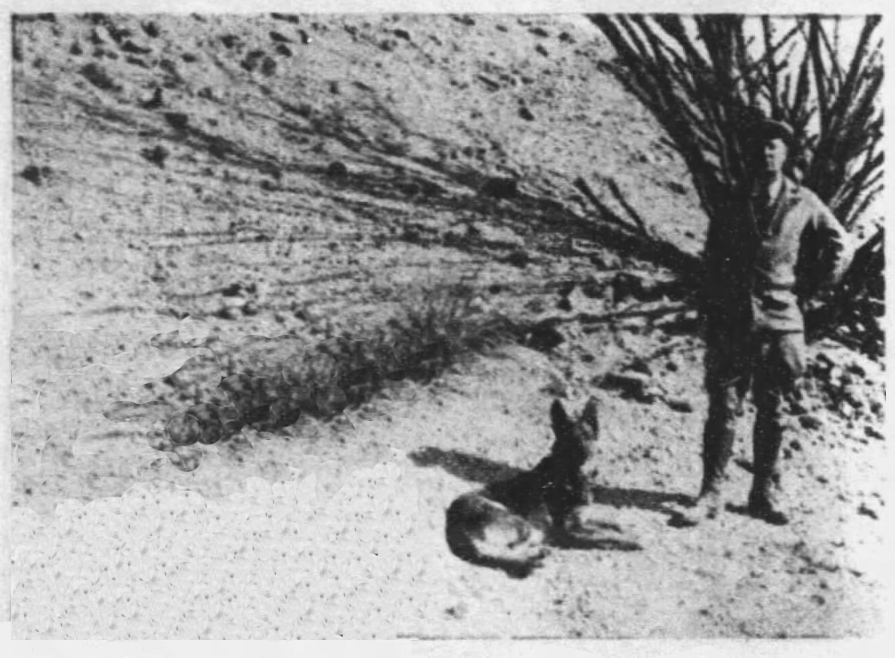
Mr. Gardner is at home in the Southwest.
This, then, is how the man lives whose latest and best novel begins next week in these pages. A novel of the modern bad men of the Southwest. The story of a lost gold mine. A story of adventure, of crime and love. A story packed with thrills and fast-moving action, with breathless suspense and a romance as tender and as strong as the rugged land in which it takes place. Watch for “Fugitive Gold” by Erie Stanley Gardner—in our next issue.
- Download “An Adventure Every Day” (May 19, 1935, This Week)





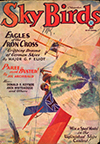
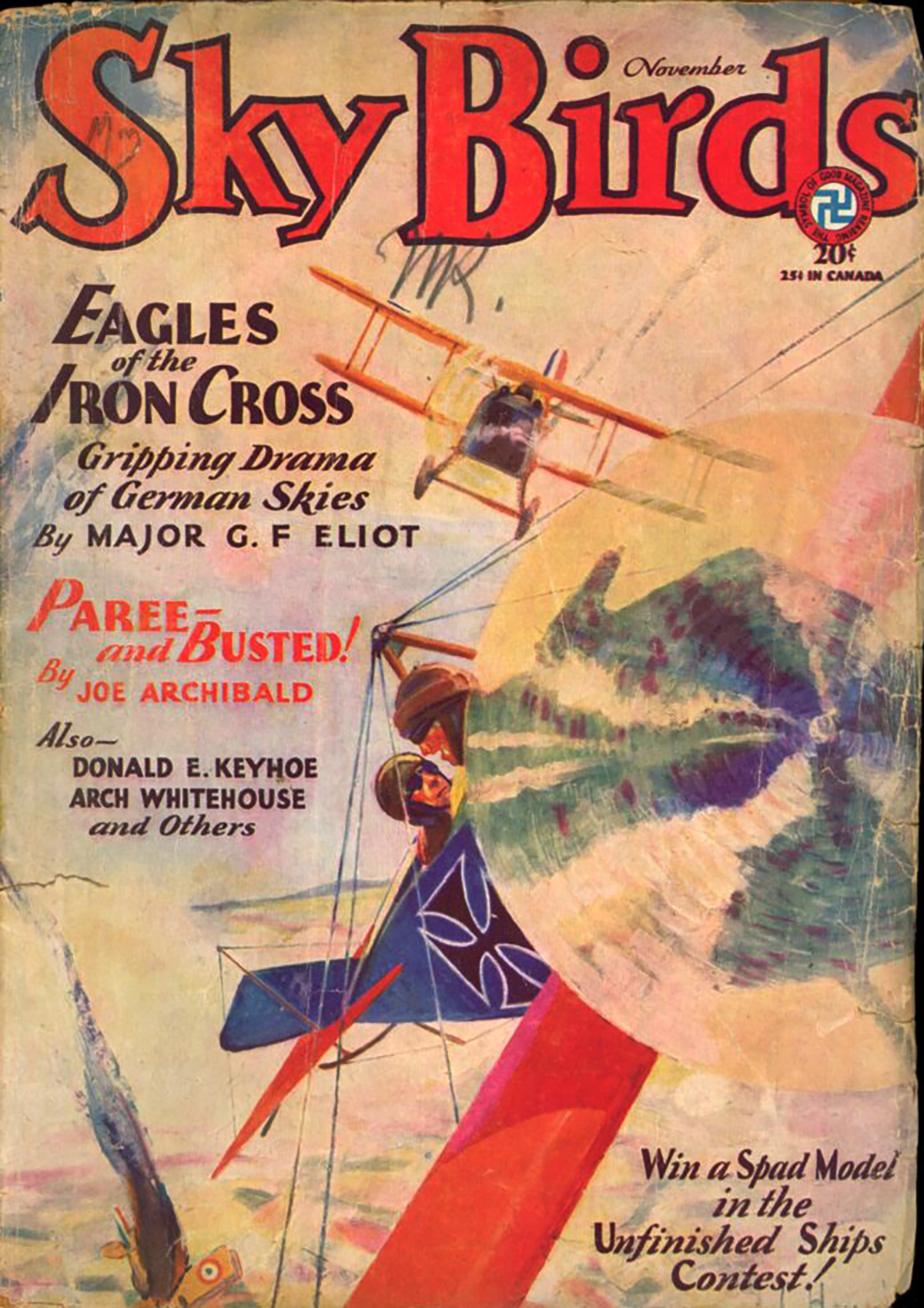
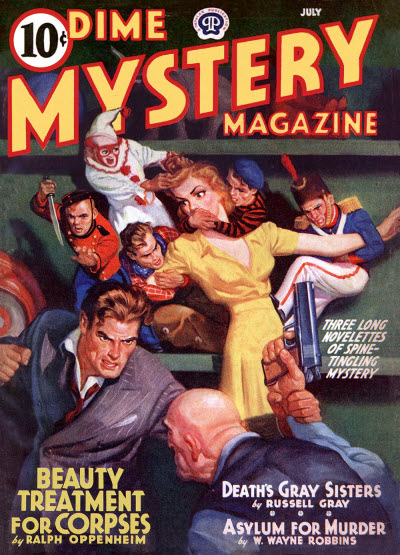 the Bystander’s eye is caught by a girl reminiscent of one from his past that leads him to a rotting corpse that had been very much alive moments before. The girl’s own sister tries to hire Craig to investigate why her own body seems to be rotting away until her husband phones and tells her not to. That’s like waving a bone in front of a dog and Craig can’t help but investigate this bizarre series of deaths! From the July 1940 issue of Dime Mystery Magazine it’s Ralph Oppenheim’s Bystander in “Beauty Treatments for Corpses!”
the Bystander’s eye is caught by a girl reminiscent of one from his past that leads him to a rotting corpse that had been very much alive moments before. The girl’s own sister tries to hire Craig to investigate why her own body seems to be rotting away until her husband phones and tells her not to. That’s like waving a bone in front of a dog and Craig can’t help but investigate this bizarre series of deaths! From the July 1940 issue of Dime Mystery Magazine it’s Ralph Oppenheim’s Bystander in “Beauty Treatments for Corpses!”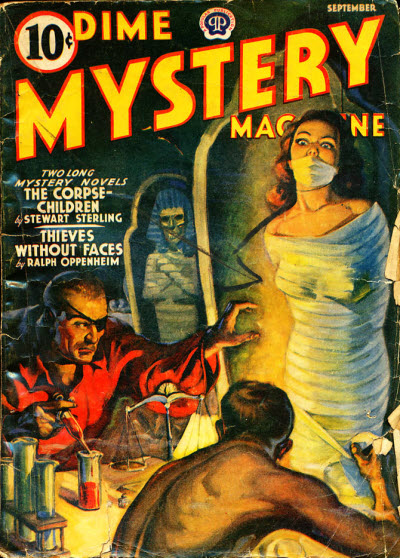 clear lovely Anne Ferris of a shop-lifting charge, he could not guess what was waiting for him. In all his long years of fighting crime, the Bystander had never seen anything like those vastly, distorted corpses—or that he was putting himself into the power of a monstrous murder syndicate whose victims died with the flesh decaying on their bodies! The Bystander found himself trapped and helpless—while they prepared for their last, most fiendish act of all!
clear lovely Anne Ferris of a shop-lifting charge, he could not guess what was waiting for him. In all his long years of fighting crime, the Bystander had never seen anything like those vastly, distorted corpses—or that he was putting himself into the power of a monstrous murder syndicate whose victims died with the flesh decaying on their bodies! The Bystander found himself trapped and helpless—while they prepared for their last, most fiendish act of all!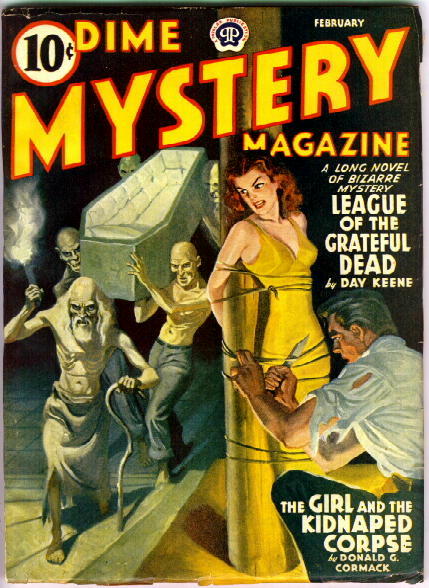 to help the police find the maker of those hideous, purple corpses. But then people began taking pot shots at him from dark corners, and he realized that Ahmed Bey and company had no real interest in his further health. And the Bystander was never the man to turn down a dare—especially from Death! For the death-loaded touch of an invisible finger was turning lovely young girls into rigid corpses—hideously purple!
to help the police find the maker of those hideous, purple corpses. But then people began taking pot shots at him from dark corners, and he realized that Ahmed Bey and company had no real interest in his further health. And the Bystander was never the man to turn down a dare—especially from Death! For the death-loaded touch of an invisible finger was turning lovely young girls into rigid corpses—hideously purple!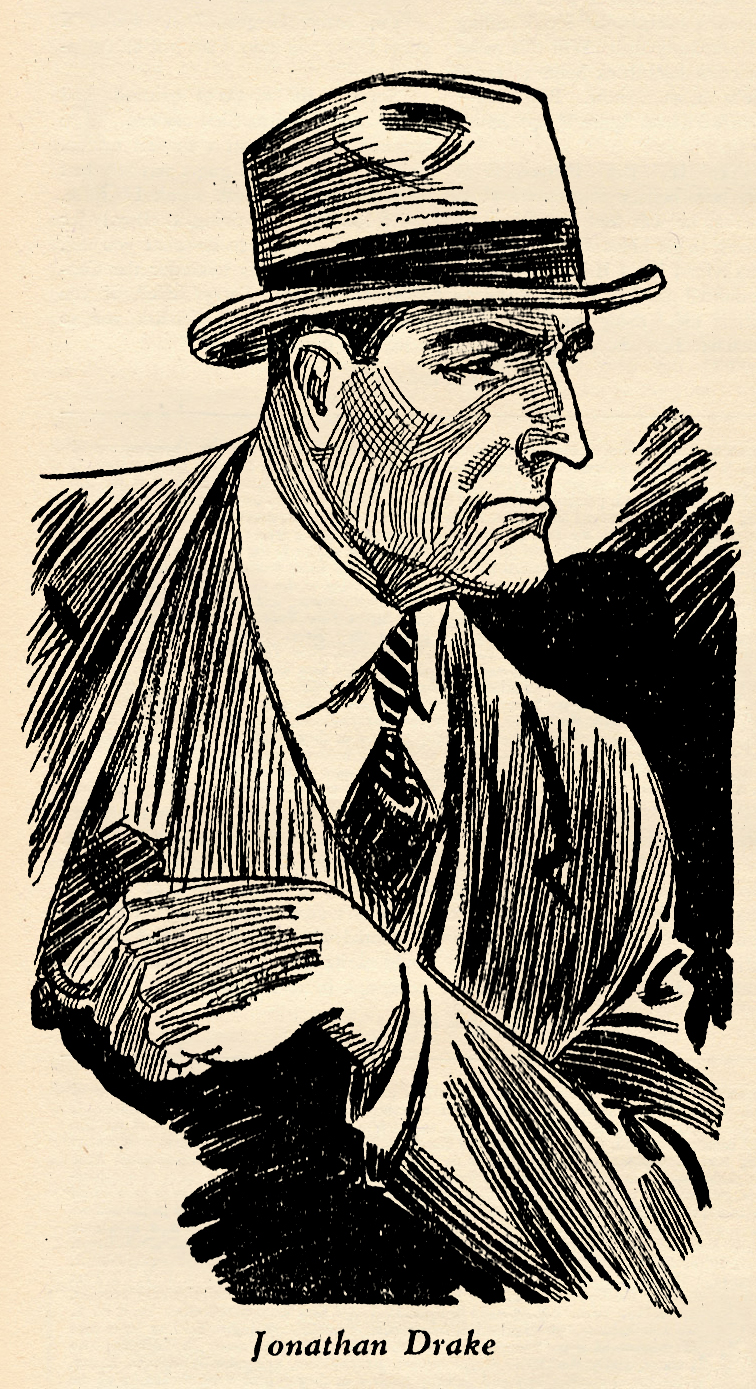 This brings us to Jonathan Drake, Ace Manhunter, from the pages of Black Book Detective! Drake appeared in three consecutive issues of the Black Book, but the three stories were written by three different authors. Oppenheim wrote the first of the three stories which introduced the character. Drake was a world-renown criminologist frequently called in to work with the police on their toughest, most baffling cases! The details of these cases were recorded in huge black loose-leaf volumes—his Black Book of Crime!
This brings us to Jonathan Drake, Ace Manhunter, from the pages of Black Book Detective! Drake appeared in three consecutive issues of the Black Book, but the three stories were written by three different authors. Oppenheim wrote the first of the three stories which introduced the character. Drake was a world-renown criminologist frequently called in to work with the police on their toughest, most baffling cases! The details of these cases were recorded in huge black loose-leaf volumes—his Black Book of Crime!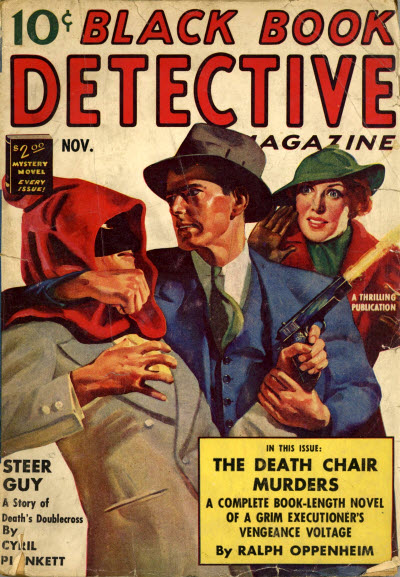 and gets the plot going with a grisley electrocution before introducing our hero (a page long descriptive that is repeated word for word in the second story by Donald Stuart (aka Gerald Verner)). When a second victim is found by a manhole still hooked to the city’s electrical grid and burning, Drake tries to find a connection between the two. This leads to four other men—all six had worked a number of years ago for the Triconi mob and now a shadowy Executioner seem to be exacting revenge for the mob—at least that’s how things appear. Will Drake be able to discern the motive behind the murders, unmask The Executioner, and save the lives of the other four men? Find out in Ralph Oppenheim’s “The Death Chair Murders” from the pages of the November 1938 Black Book Detective!
and gets the plot going with a grisley electrocution before introducing our hero (a page long descriptive that is repeated word for word in the second story by Donald Stuart (aka Gerald Verner)). When a second victim is found by a manhole still hooked to the city’s electrical grid and burning, Drake tries to find a connection between the two. This leads to four other men—all six had worked a number of years ago for the Triconi mob and now a shadowy Executioner seem to be exacting revenge for the mob—at least that’s how things appear. Will Drake be able to discern the motive behind the murders, unmask The Executioner, and save the lives of the other four men? Find out in Ralph Oppenheim’s “The Death Chair Murders” from the pages of the November 1938 Black Book Detective!
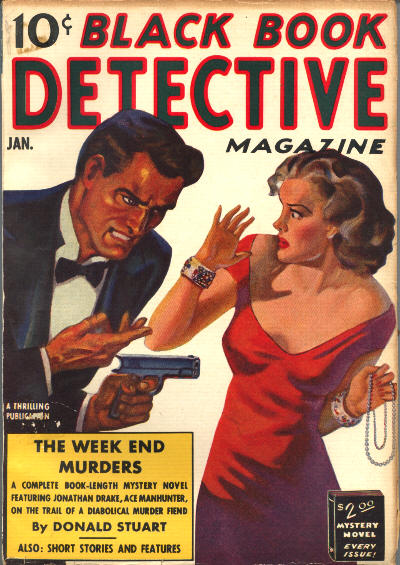 at Backwaters he was not looking forward to his visit with any degree of anticipation. He had no prevision of the tragic events that would take place—but he disliked the average week end house party. This, however, did not turn out to be an average week end house party. From the moment he entered the estate of Montague Hammond, theatrical producer, he was gripped with a strange sense of foreboding. There was death in the warm summer air, bitter hate in the glance of the week end guests when they looked at each other. Then—murder!
at Backwaters he was not looking forward to his visit with any degree of anticipation. He had no prevision of the tragic events that would take place—but he disliked the average week end house party. This, however, did not turn out to be an average week end house party. From the moment he entered the estate of Montague Hammond, theatrical producer, he was gripped with a strange sense of foreboding. There was death in the warm summer air, bitter hate in the glance of the week end guests when they looked at each other. Then—murder!
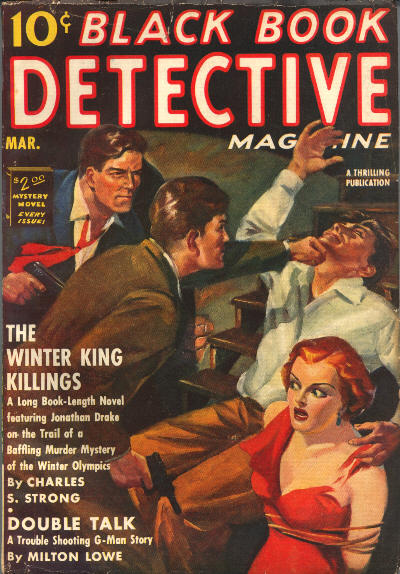 aboard the Griffholm in New York Harbor, he was expecting nothing more than a routine job of investigation into the business of a Winter Olympic Star Sports Group. He had no idea that before he reached the upper deck he would be faced with the fiendish murder of the piquant and attractive Scandinavian skating star, Svana Hanson.
aboard the Griffholm in New York Harbor, he was expecting nothing more than a routine job of investigation into the business of a Winter Olympic Star Sports Group. He had no idea that before he reached the upper deck he would be faced with the fiendish murder of the piquant and attractive Scandinavian skating star, Svana Hanson.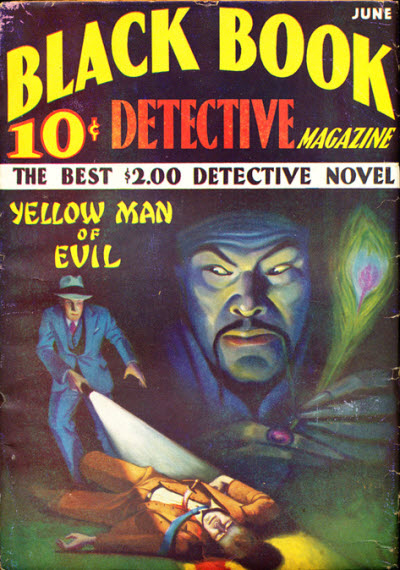 BLACK BOOK MAGAZINE first hit the newsstands with the June 1933 issue. For the next six years, it tried different approaches to success. Issue one began with a featured novel and several backup short stories. The following year it started promoting “three new complete novels” in each magazine, but abandoned that approach after four issues. It then tried shorter novelets, combined with short stories. By April 1935, the magazine went on an extended hiatus to return in January 1936 with a “weird menace” approach with scantily-clad women in peril or skulls and severed heads on the covers before going on a break again.
BLACK BOOK MAGAZINE first hit the newsstands with the June 1933 issue. For the next six years, it tried different approaches to success. Issue one began with a featured novel and several backup short stories. The following year it started promoting “three new complete novels” in each magazine, but abandoned that approach after four issues. It then tried shorter novelets, combined with short stories. By April 1935, the magazine went on an extended hiatus to return in January 1936 with a “weird menace” approach with scantily-clad women in peril or skulls and severed heads on the covers before going on a break again.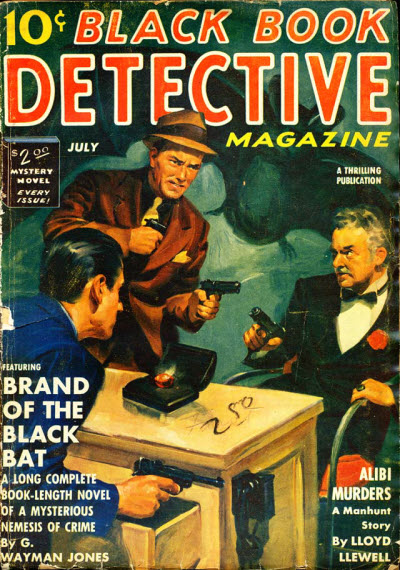 embraced the Ace Manhunter as the editors had hoped and in the “Off The Record” column in the March 1939 issue, the editors were already promoting Rick LeRoy, famous globe-trotting detective by Barry Perowne for the next issue. Perowne’s LeRoy had previously appeared in the pages of The Thriller.
embraced the Ace Manhunter as the editors had hoped and in the “Off The Record” column in the March 1939 issue, the editors were already promoting Rick LeRoy, famous globe-trotting detective by Barry Perowne for the next issue. Perowne’s LeRoy had previously appeared in the pages of The Thriller.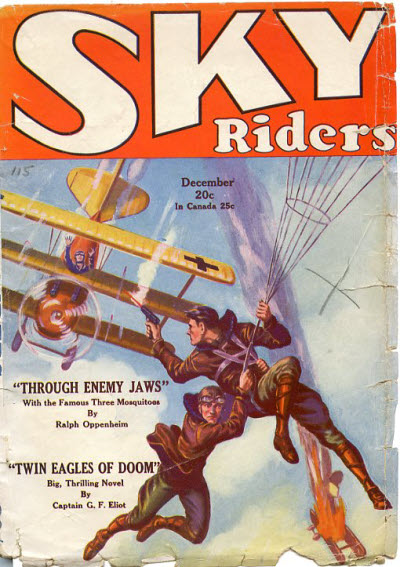 the third and final of three Ralph Oppenheim’s Three Mosquitoes stories we’re featuring this March for Mosquito Month! And this one’s a doozy! Allied intelligence had learned that the Germans had built a great seaplane, destined to turn the whole tide of the naval war. This seaplane was not only a compact fighting and raiding ship, but it could make remarkable speed and cover remarkable distance. It was even rumored that the Germans proposed to send a whole fleet of these new planes across the Atlantic, with the object of raiding the American coast!
the third and final of three Ralph Oppenheim’s Three Mosquitoes stories we’re featuring this March for Mosquito Month! And this one’s a doozy! Allied intelligence had learned that the Germans had built a great seaplane, destined to turn the whole tide of the naval war. This seaplane was not only a compact fighting and raiding ship, but it could make remarkable speed and cover remarkable distance. It was even rumored that the Germans proposed to send a whole fleet of these new planes across the Atlantic, with the object of raiding the American coast! 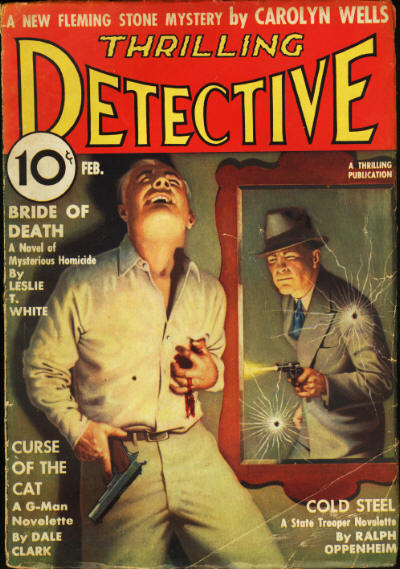 in the pages of Thrilling Detective—the first two in 1936 and 1937 featured Dave Rogers. Dave Rogers was a motorcycle riding state trooper. In this second of the two published tales, a former state trooper, young Bob Hall, has returned to the station as a Federal Agent investigating a counterfeiting ring that is believed to be operating in the area. Rogers says he’s seen one of the three counterfeiters in the area, but is asked to give Hall a wide berth in his investigation. However, when young Bob Hall turns up frozen solid just a short time after Rogers has seen him speeding by on the other side of town, he throws himself into the case!
in the pages of Thrilling Detective—the first two in 1936 and 1937 featured Dave Rogers. Dave Rogers was a motorcycle riding state trooper. In this second of the two published tales, a former state trooper, young Bob Hall, has returned to the station as a Federal Agent investigating a counterfeiting ring that is believed to be operating in the area. Rogers says he’s seen one of the three counterfeiters in the area, but is asked to give Hall a wide berth in his investigation. However, when young Bob Hall turns up frozen solid just a short time after Rogers has seen him speeding by on the other side of town, he throws himself into the case!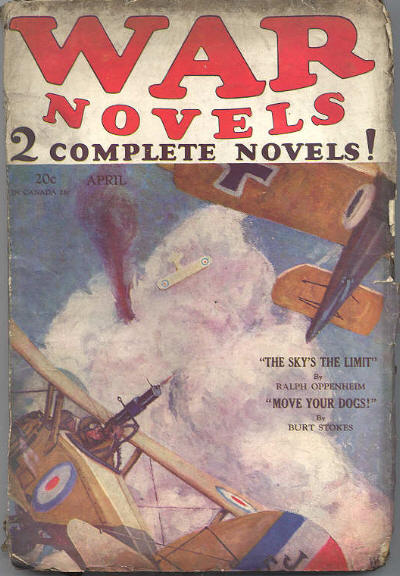 the second of three tales of Ralph Oppenheim’s Three Mosquitoes we’re featuring this March for Mosquito Month! This one is epic! The “Flying Dutchman” and his Circus have been overwhelming the Allied squadrons up and down the Western Front with their sheer numbers. Needless to say Kirby wants to take out the “Flying Dutchman”—Kellar—and put an end to his Circus. They go up again each other several times with alternating fortunes and develop a mutual admiration and respect for one another. Unfortunately, the Western Front is not big enough for both Aces.
the second of three tales of Ralph Oppenheim’s Three Mosquitoes we’re featuring this March for Mosquito Month! This one is epic! The “Flying Dutchman” and his Circus have been overwhelming the Allied squadrons up and down the Western Front with their sheer numbers. Needless to say Kirby wants to take out the “Flying Dutchman”—Kellar—and put an end to his Circus. They go up again each other several times with alternating fortunes and develop a mutual admiration and respect for one another. Unfortunately, the Western Front is not big enough for both Aces.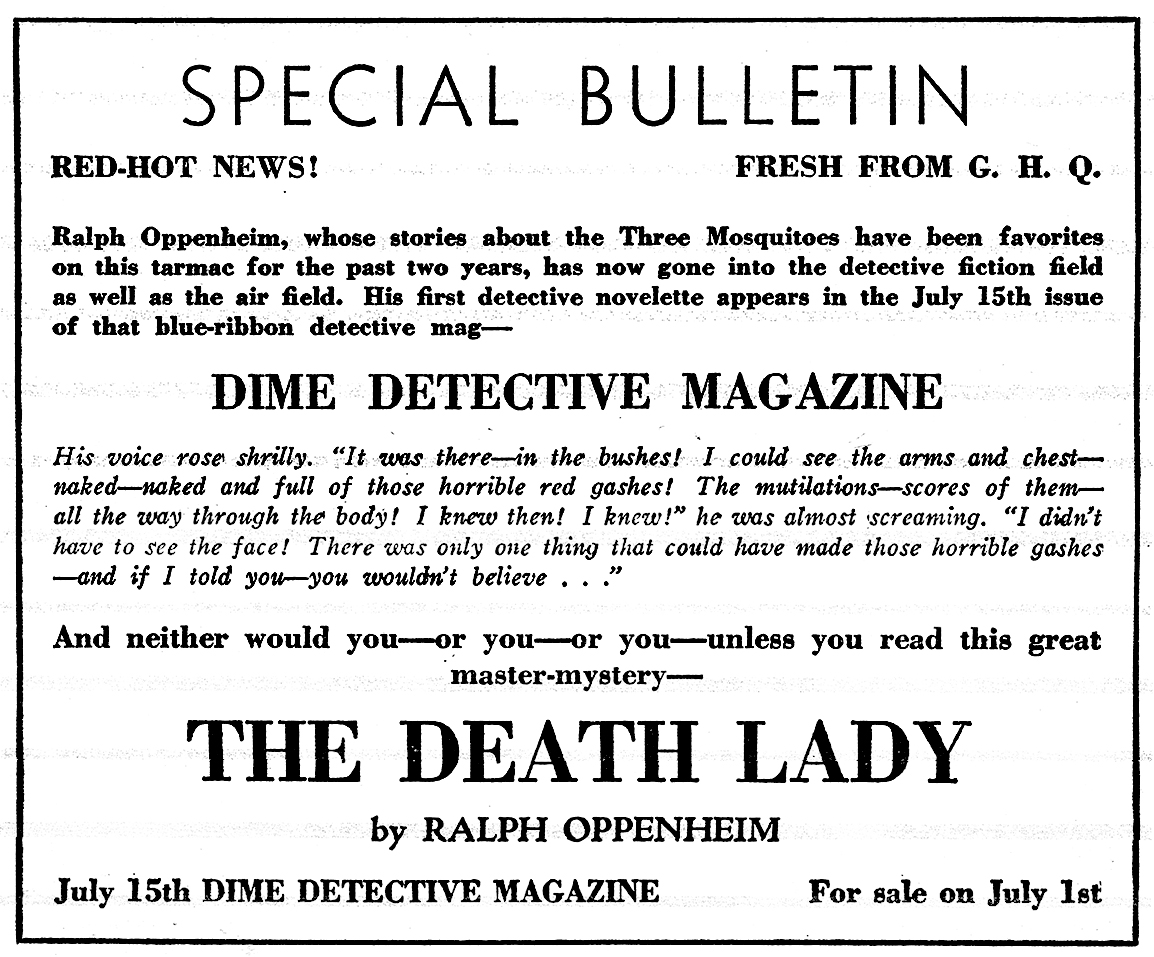
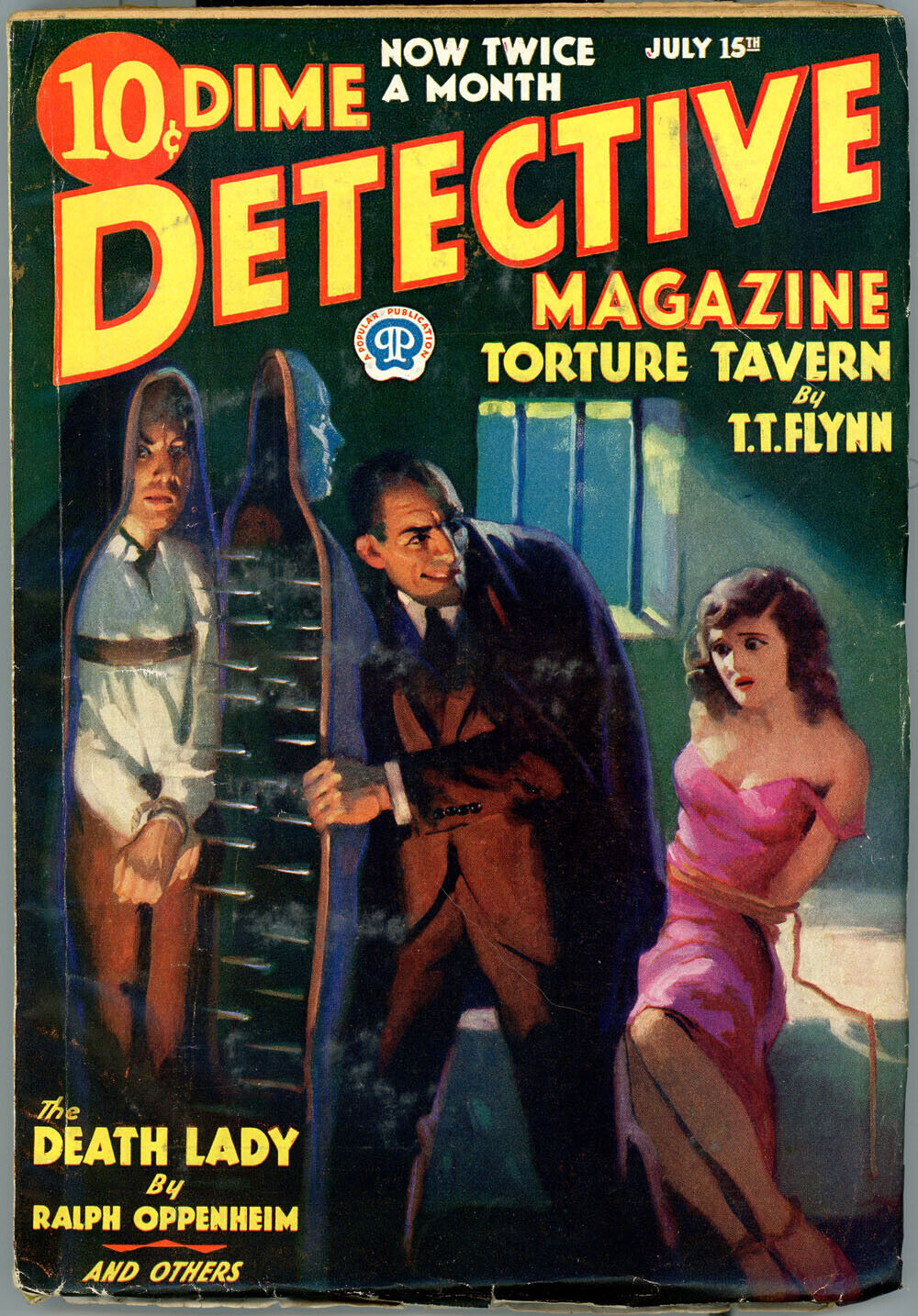
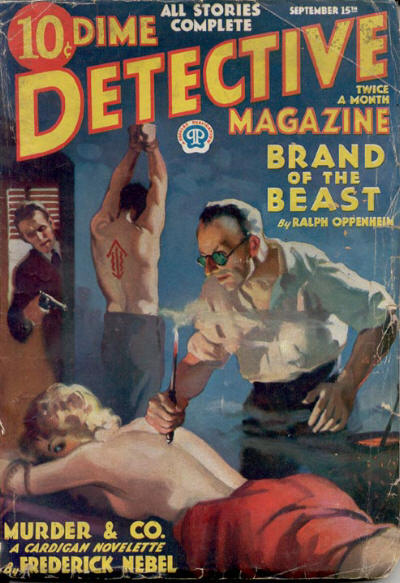
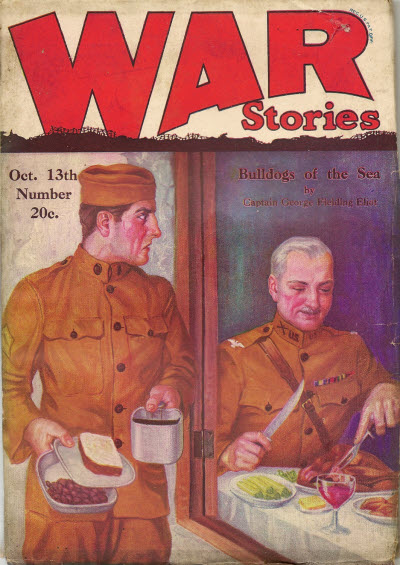 off the ground with an early Mosquitoes tale from the pages of the October 13th, 1927 issue of War Stories. The great German Ace Breikhart has been making his personal mission to down any observation balloon the allies have up. As a result, our intrepid trio has been assigned the task of protecting the observation balloons. An assignment Kirby finds boring and beneath his capabilities, until…
off the ground with an early Mosquitoes tale from the pages of the October 13th, 1927 issue of War Stories. The great German Ace Breikhart has been making his personal mission to down any observation balloon the allies have up. As a result, our intrepid trio has been assigned the task of protecting the observation balloons. An assignment Kirby finds boring and beneath his capabilities, until…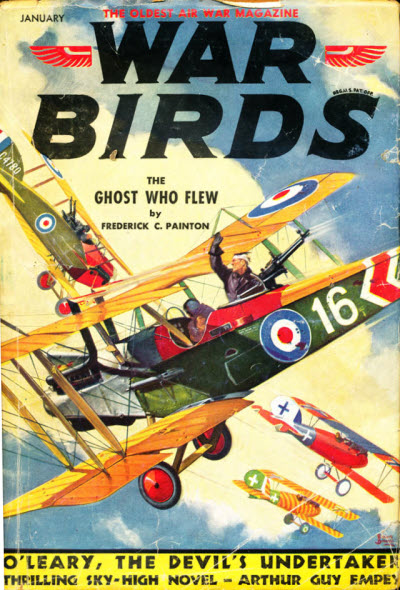 pen of the Navy’s own Allan R. Bosworth. Bosworth wrote a couple dozen stories with Humpy & Tex over the course of ten years from 1930 through 1939, mostly in the pages of War Aces and War Birds. The stories are centered around the naval air base at Ile Tudy, France. “Humpy” Campbell, a short thickset boatswain’s mate, first class who was prone to be spitting great sopping globs of tabacco juice, was a veteran seaplane pilot who would soon rate two hashmarks—his observer, Tex Malone, boatswain’s mate, second class, was a D.O.W. man fresh from the Texas Panhandle. Everybody marveled at the fact that the latter had made one of the navy’s most difficult ratings almost overnight—but the answer lay in his ability with the omnipresent rope he constantly carried.
pen of the Navy’s own Allan R. Bosworth. Bosworth wrote a couple dozen stories with Humpy & Tex over the course of ten years from 1930 through 1939, mostly in the pages of War Aces and War Birds. The stories are centered around the naval air base at Ile Tudy, France. “Humpy” Campbell, a short thickset boatswain’s mate, first class who was prone to be spitting great sopping globs of tabacco juice, was a veteran seaplane pilot who would soon rate two hashmarks—his observer, Tex Malone, boatswain’s mate, second class, was a D.O.W. man fresh from the Texas Panhandle. Everybody marveled at the fact that the latter had made one of the navy’s most difficult ratings almost overnight—but the answer lay in his ability with the omnipresent rope he constantly carried.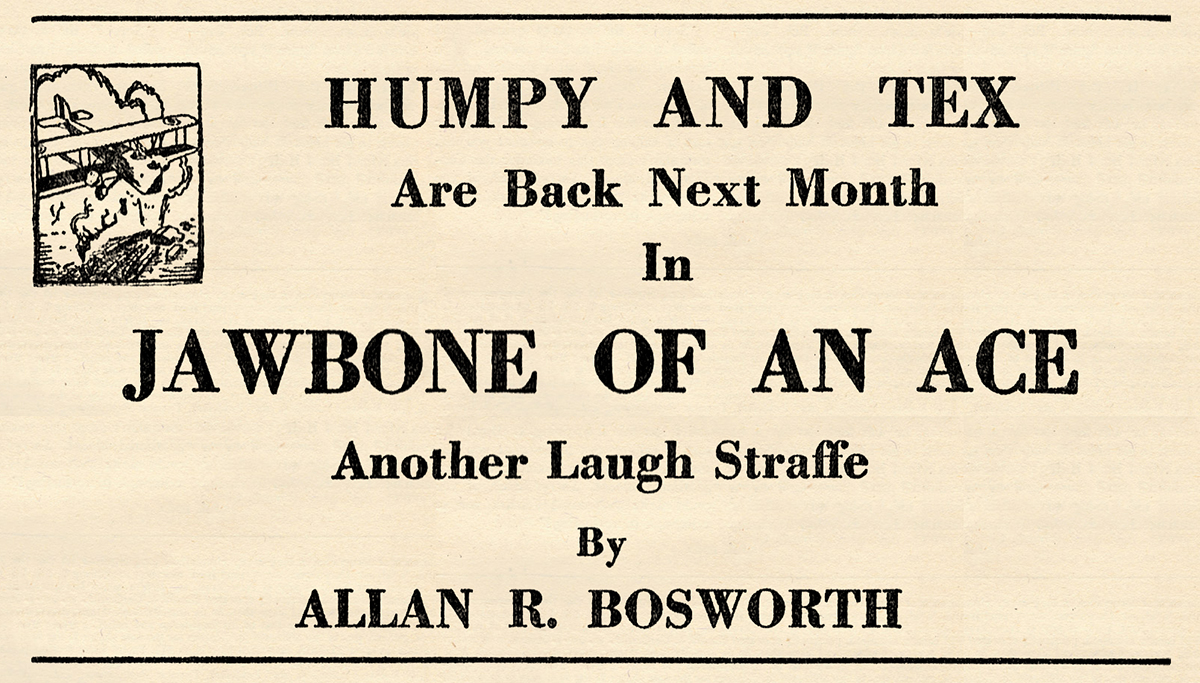
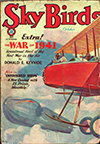

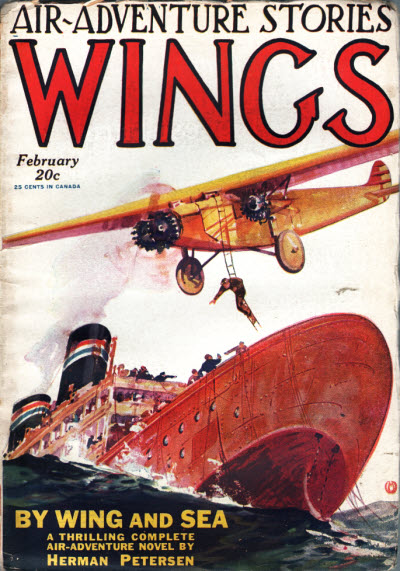 a short story by renowned pulp author Frederick C. Davis. Davis is probably best remembered for his work on Operator 5 where he penned the first 20 stories, as well as the Moon Man series for Ten Detective Aces and several other continuing series for various Popular Publications. He also wrote a number of aviation stories that appeared in Aces, Wings and Air Stories.
a short story by renowned pulp author Frederick C. Davis. Davis is probably best remembered for his work on Operator 5 where he penned the first 20 stories, as well as the Moon Man series for Ten Detective Aces and several other continuing series for various Popular Publications. He also wrote a number of aviation stories that appeared in Aces, Wings and Air Stories. 
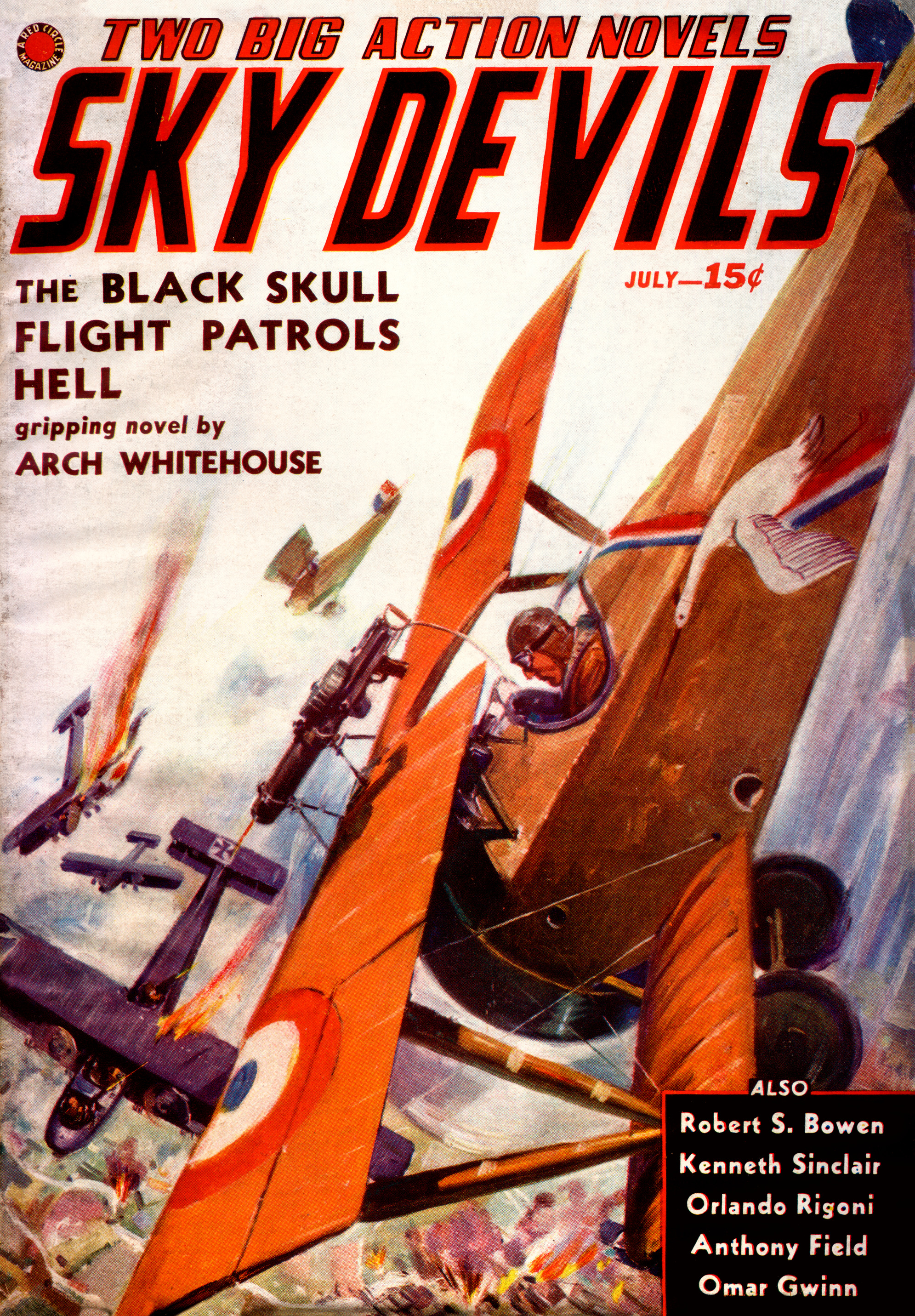 a story from the short-lived Sky Devils magazine by Anthony Field. Anthony Field was a pseudonym used by Anatole Feldman who specialized in gangland fiction—appearing primarily in Harold Hersey’s gang pulps, Gangster Stories, Racketeer Stories, and Gangland Stories. His best-known creation is Chicago gangster Big Nose Serrano. But he also wrote a number of aviation stories including four stories for Sky Devils featuring Quinn’s Black Sheep Squadron—this is the second of those four stories!
a story from the short-lived Sky Devils magazine by Anthony Field. Anthony Field was a pseudonym used by Anatole Feldman who specialized in gangland fiction—appearing primarily in Harold Hersey’s gang pulps, Gangster Stories, Racketeer Stories, and Gangland Stories. His best-known creation is Chicago gangster Big Nose Serrano. But he also wrote a number of aviation stories including four stories for Sky Devils featuring Quinn’s Black Sheep Squadron—this is the second of those four stories!